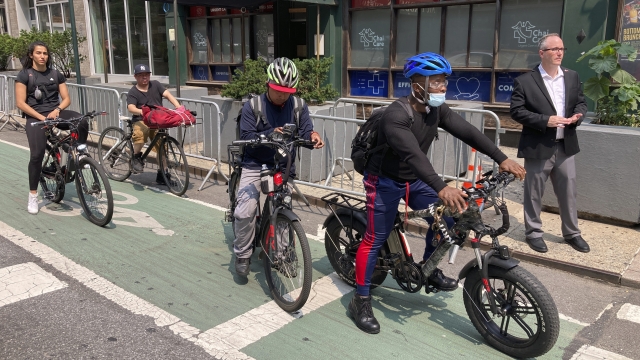For Jeremiah Lowery, bicycling is his main mode of transportation around his hometown of Washington, D.C. Yet, he said it's not without risk.
"I was walking my bike across the crosswalk, and it was a red light for the driver, but I had the walk signal — and the driver sped around the corner," said Lowery, who is with the Washington Area Bicyclist Association. "Luckily, I got out the way, but the driver totally crushed my bike."
That ability of drivers to make a right turn on red is under threat in more and more cities, which are opting to ban the practice because they say it will make the roads safer for those in the pedestrian crosswalks.
"A blanket ban does not make any sense from either a safety standpoint or for an efficiency standpoint," said Jay Beeber, executive director of policy for the National Motorists Association.
He said banning a "right on red" adds fuel costs and time spent to drivers, from vehicles idling at a red light, when they could turn. Beeber also said that data from a study the association conducted did not find a ban would make things safer.
"We've done a study in which we looked at the fatalities in the state of California," he said. "We found that before the entire state of California, the number of 'right turn on red' fatalities is less than one per year in the entire state."
Cities around the country, though, are considering banning 'right turns on red,' including Denver, Chicago, Seattle, San Francisco and Los Angeles. A ban has been in place for decades in most of New York City and one is now in place in downtown Ann Arbor, Michigan. Washington D.C.'s ban is set to go into effect in 2025.
Pedestrian deaths across the country are up 77% since 2010, according to the Governor's Highway Safety Association. They found that more than 7,500 people were killed while walking in 2022, the most pedestrians killed since 1981.
SEE MORE: Children's bicycles recalled due to faulty handlebars
"A lot of our roadway policies have been very car-centric and I think a 'no right on red' type of policy does put pedestrians on perhaps better footing than they were before," said Mark Chung, EVP of roadway practice at the National Safety Council.
He added that the bans have a wider reach than just protecting pedestrians.
"It's not just people on foot. It's bicyclists, it's people on e-scooters and others — that cars are just part of this overall network and that we all need to be respectful of one another," Chung said. "And also respect the laws of the road, to make sure that everyone can get to points A to B in a safe manner."
However, is it just the rules of the road that are behind the increase in pedestrian fatalities?
As the Insurance Institute for Highway Safety recently told Scripps News, it's more complicated than that, and may also have something to do with the vehicles themselves.
"SUVs and pickups are more likely to be involved in turning crashes at intersections with pedestrians compared to cars," said Jessica Cicchino with the IIHS, "and that suggests there might be something going on with their blind spots."
In the meantime, the debate over banning a right on red, rolls on.
"[Bans at] individual intersections may make sense," Beeber said. "Blanket bans do not make sense."
Before heading off on his bicycle, Lowery had a different take.
"I think we need to have uniformity with some of our traffic laws and we just need to have a blanket ban," he said.
It's a division that remains over safety on America's streets.
Trending stories at Scrippsnews.com





